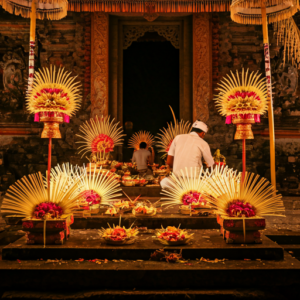
Balinese culture is deeply rooted in a holistic approach to health and well-being, combining physical, spiritual, and environmental harmony. This philosophy is vividly reflected in its traditional herbal medicine, known locally as „Usada Bali.“ Usada Bali, an ancient practice passed down through generations, utilizes the island’s rich biodiversity to create natural remedies. From treating common ailments to enhancing overall health, these herbal practices form an integral part of Balinese daily life and their traditional healing system.
The Origins and Philosophy of Usada Bali
Usada Bali has its origins in ancient Balinese texts known as „Lontar Usada,“ which date back to the Majapahit period around the 14th century. These texts detail a vast array of medicinal plants, their uses, and methods of preparation. The knowledge enshrined in these manuscripts is believed to be divinely inspired, blending empirical wisdom with spiritual insights.
The philosophy behind Usada Bali is holistic, emphasizing the balance between the physical body, the mind, and the spirit. It is deeply connected to the concept of „Tri Hita Karana,“ which promotes harmony between humans, nature, and the spiritual realm. This holistic view considers illness not just as a physical ailment but often as an imbalance in one’s spiritual and emotional states, requiring a comprehensive approach to healing.
The Role of the Balian: Balinese Healers
Central to the practice of Usada Bali are the „Balian,“ traditional healers who are highly respected within Balinese society. Balian undergo extensive training, often inheriting knowledge through familial lines or rigorous apprenticeships. Their training includes understanding the medicinal properties of plants, diagnosing ailments, and conducting spiritual rituals to restore balance and health.
A Balian’s practice is multifaceted, combining physical treatments with spiritual rituals. They often perform diagnostic rituals, such as meditative trance states or consultations with spiritual entities, to determine the underlying cause of an illness. Treatment may involve herbal remedies, massages, and spiritual offerings to appease ancestral spirits or deities.
Common Herbal Remedies and Their Uses
The Balinese landscape is a natural pharmacy, abundant with medicinal plants and herbs. Here are some of the most commonly used herbs in traditional Balinese medicine:
- 1. Turmeric (Curcuma longa)
Turmeric, known as „kunyit“ in Balinese, is a cornerstone of traditional medicine. It is renowned for its anti-inflammatory, antioxidant, and antimicrobial properties. Turmeric is often used to treat digestive issues, skin conditions, and respiratory ailments. It is also a key ingredient in „Jamu,“ a traditional herbal drink believed to enhance overall health and vitality.
- 2. Ginger (Zingiber officinale)
Ginger, or „jahe,“ is another staple in Balinese herbal medicine. It is valued for its ability to alleviate nausea, improve digestion, and relieve pain. Ginger is commonly used in teas and decoctions to treat colds, flu, and stomach upsets. Its warming properties make it particularly useful for balancing the body during the cooler, rainy seasons.
- 3. Galangal (Alpinia galanga)
Known locally as „lengkuas,“ galangal is similar to ginger but with a distinct, sharper flavor. It is used to treat respiratory infections, digestive issues, and inflammation. Galangal is often included in herbal compresses and poultices applied to bruises and sprains to reduce pain and swelling.
- 4. Tamarind (Tamarindus indica)
Tamarind, or „asem,“ is used for its laxative properties and is an effective remedy for digestive problems, including constipation and bloating. It is also used in various skin treatments due to its antimicrobial properties, helping to treat infections and promote wound healing.
- 5. Betel Leaf (Piper betle)
Betel leaf, or „daun sirih,“ is commonly used in Balinese herbal medicine for its antiseptic and anti-inflammatory properties. Chewing betel leaves is believed to strengthen teeth and gums, while topical applications can treat skin infections and reduce inflammation.
Preparation and Application Methods
Balinese herbal medicine employs various preparation methods to maximize the efficacy of the herbs. These methods are often simple yet effective, ensuring that the medicinal properties of the plants are preserved and enhanced.
- 1. Jamu
Jamu is a traditional herbal drink made from a blend of various roots, leaves, and spices. Turmeric, ginger, and tamarind are common ingredients. Jamu is consumed daily by many Balinese as a preventive measure to maintain health and vitality. Each family or healer may have their own special recipe, often kept as a closely guarded secret.
- 2. Herbal Teas and Decoctions
Herbal teas and decoctions are a common way to administer medicinal herbs. Fresh or dried herbs are boiled in water to extract their active compounds. These herbal brews are used to treat a wide range of ailments, from colds and flu to digestive issues and fatigue.
- 3. Poultices and Compresses
Poultices and compresses involve applying a mixture of crushed herbs directly to the skin. This method is particularly effective for treating external conditions such as wounds, bruises, and skin infections. Herbs like galangal and betel leaf are frequently used in this manner.
- 4. Oils and Balms
Herbal oils and balms are made by infusing medicinal plants in carrier oils. These are used for massages to relieve muscle pain, improve circulation, and promote relaxation. Essential oils derived from plants like eucalyptus and lemongrass are also popular for their soothing and healing properties.
Spiritual and Ritualistic Aspects
The spiritual aspect of Balinese herbal medicine is as important as the physical treatment. Many Balinese believe that physical ailments are often linked to spiritual imbalances or disturbances. Therefore, healing rituals and offerings are an integral part of the treatment process.
Balian may perform rituals to cleanse the aura, remove negative energies, and restore spiritual balance. These rituals often involve offerings of flowers, fruits, and incense to appease the gods and ancestral spirits. The healing process is seen as a way to harmonize the body, mind, and spirit, reflecting the holistic nature of Usada Bali.
Modern Integration and Challenges
While traditional Balinese herbal medicine remains deeply respected and widely practiced, it faces challenges in the modern world. The rise of Western medicine and pharmaceuticals offers faster, more convenient treatment options, which can sometimes overshadow traditional practices.
However, there is a growing movement to integrate traditional and modern medicine, recognizing the value of both. Many Balinese now seek a balance between the two, using herbal remedies for preventive care and minor ailments while turning to modern medicine for more serious conditions.
The preservation of traditional knowledge is also a critical issue. Efforts are being made to document and protect the wisdom contained in the Lontar Usada and to ensure that younger generations continue to learn and practice these ancient healing arts. Organizations and educational programs are working to promote sustainable harvesting of medicinal plants and to support the Balian in their vital role within the community.
Conclusion
Traditional Balinese herbal medicine, with its rich history and holistic philosophy, offers a profound connection to nature and a unique approach to health and healing. Usada Bali reflects a deep understanding of the interconnectedness of physical, spiritual, and environmental health. By blending ancient wisdom with modern practices, Balinese herbal medicine continues to thrive, offering natural remedies that promote well-being and harmony. Whether through a cup of Jamu, a soothing herbal poultice, or a spiritual healing ritual, the legacy of Usada Bali endures as a testament to the enduring power of nature’s remedies.





